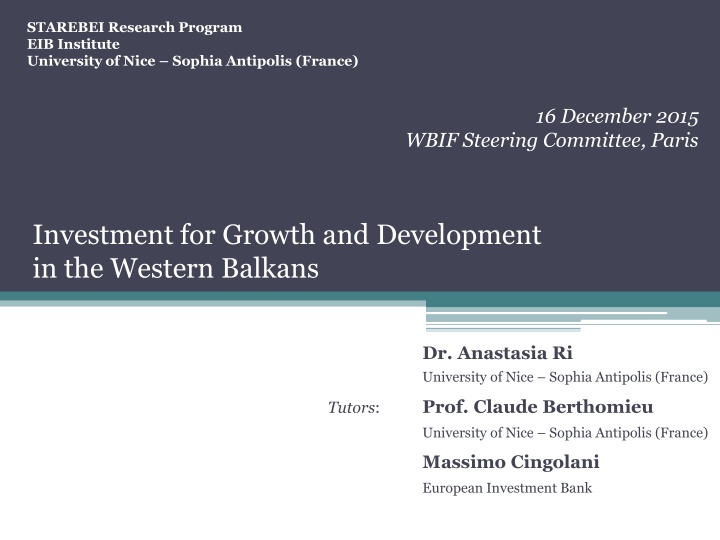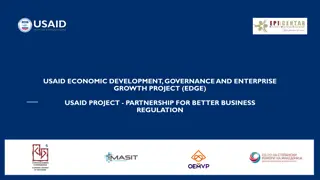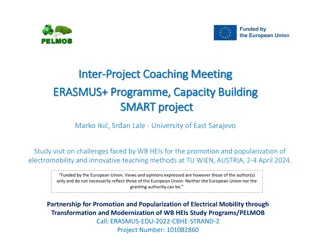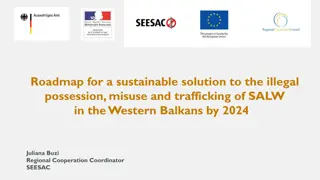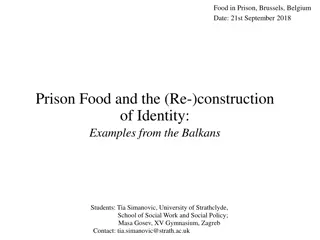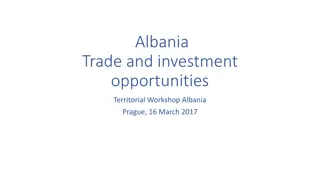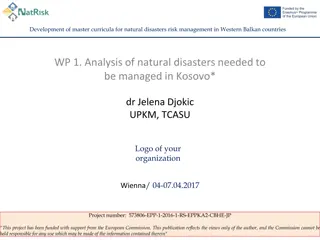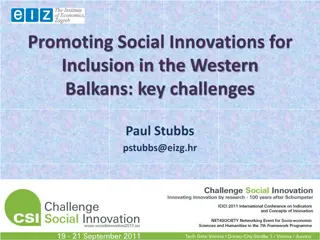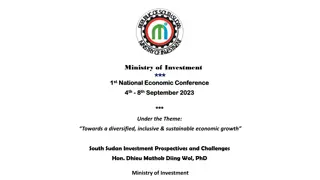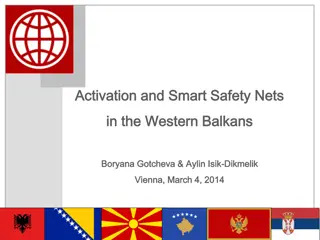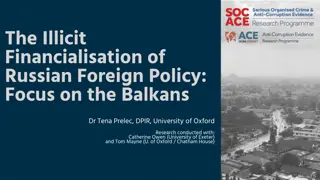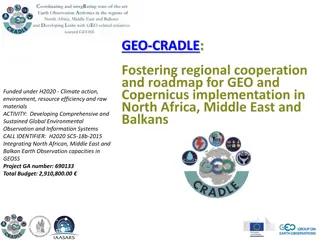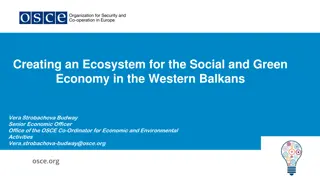Investment for Growth and Development in the Western Balkans
This research program conducted at the University of Nice Sophia Antipolis in France delves into the urgent need for more investment in the Western Balkans. The analysis covers topics such as macroeconomic data, infrastructure requirements, convergence towards EU standards, debt implications, employment goals, and the necessity for policy coordination at a regional level. The study outlines medium-term investment estimates in various sectors and evaluates different scenarios for required investments. It also highlights the critical employment situation in the region based on data from international sources.
Uploaded on Mar 01, 2025 | 1 Views
Download Presentation

Please find below an Image/Link to download the presentation.
The content on the website is provided AS IS for your information and personal use only. It may not be sold, licensed, or shared on other websites without obtaining consent from the author.If you encounter any issues during the download, it is possible that the publisher has removed the file from their server.
You are allowed to download the files provided on this website for personal or commercial use, subject to the condition that they are used lawfully. All files are the property of their respective owners.
The content on the website is provided AS IS for your information and personal use only. It may not be sold, licensed, or shared on other websites without obtaining consent from the author.
E N D
Presentation Transcript
STAREBEI Research Program EIB Institute University of Nice Sophia Antipolis (France) 16 December 2015 WBIF Steering Committee, Paris Investment for Growth and Development in the Western Balkans STAREBEI Research Program Dr. Anastasia Ri University of Nice Sophia Antipolis (France) Prof. Claude Berthomieu Tutors: University of Nice Sophia Antipolis (France) Massimo Cingolani European Investment Bank
Executive Summary CHAPTER 1. WESTERN BALKANS URGE MORE INVESTMENT 1.1. Macroeconomic data analysis 1.2. Infrastructure: state and needs Transport Energy Environment Social Sector 1.3. Private sector and SMEs CHAPTER 2. CONVERGENCE, INVESTMENT, DEBT, EMPLOYMENT: ALL PIECES OF THE SAME PUZZLE 2.1. Convergence to EU-level living standards still a long journey 2.2. Investment stimulus needed to achieve development goals 2.3. Consequences for debt 2.4. Employment: the ultimate goal CHAPTER 3. COORDINATION TO ACHIEVE POLICY SYNERGIES AT REGIONAL LEVEL 3.1. Demand coordination and multipliers 3.2. Three independent small open economies 3.3. Trade interdependence without policy coordination 3.4. Trade interdependence with policy coordination CONCLUSION. INVESTMENT NEEDS AND FINANCING MIND THE GAP
3 Medium term investment needs estimates by infrastructure sector Transport Energy Environment Social sector 40 EUR bn 14.2 EUR bn (PECIs) at least >20 EUR bn no sector estimates but high needs due to chronic underinvestment, poor education enrolment ratios in some countries, poor employment performances and because of high importance of human capital for future development SRB : > 22 EUR bn SRB : 10.6 EUR bn MKD: 2.3 EUR bn SEETO Network: 31 priority projects require 6.7 EUR bn of investment Water and waste water: 16 EUR bn Just for basic infrastructure, assuming that these projects would be realized over next 10 years, EUR 7.5 bn per year of additional net investment are needed. Sources: SEETO, Energy community, Danube Water Program, national strategies, Country Strategy papers
4 , How much investment needed? (global investment needs: public and private) Low-growth or do nothing scenario Medium-growth scenario Steady or Central scenario High-growth or g=n+p g=2% g=4% g=6% on average 4.8% WB 6 WB 6 WB 6 WB 6 EUR 14 billion on average per annum EUR 23.5 billion on average per annum EUR 28 billion on average per annum EUR 35 billion on average per annum in 2014: EUR 15 billion in 2014: EUR 15 billion in 2014: EUR 15 billion in 2014: EUR 15 billion Implied investment increase EUR 8.5 billion per year Implied investment increase EUR 20 billion per year Implied investment increase EUR 13 billion per year Implied investment increase EUR -1 billion
5 Employment: critical situation Employment-to-Population ratio in 2013 (%) 60.0 52 51 50.0 46 42 41 40 39 38 40.0 33 28 30.0 20.0 10.0 0.0 HRV SRB BiH EU15 EU11 WB6 MKD KSV MNE ALB Source: International Labour Organization KILM 8thedition, World Bank (2013) Results of the Kosovo 2012 Labour Force Survey, World Bank (2014) Results of the Kosovo 2013 Labour Force Survey. .
6 Employment: the ultimate goal Steady or Central scenario Employment elasticity to growth Employment growth g= 4.8% 0.68 3% High-growth 9 Steady 12 Medium-growth 14 Low-growth 32 0 10 20 30 40 Number of years to attain EU-15 level
7 Employment: the ultimate goal Unemployment rate in 2013 (%) 35.0 30.0 High-growth 5 29.0 28.4 30.0 24.2 25.0 22.2 Steady 7 19.8 20.0 17.7 16.0 15.0 Medium-growth 8 11.2 11 10.0 Low-growth 18 5.0 0 5 10 15 20 0.0 Number of years to decrease under 10% level Source: International Labour Organization KILM 8thedition, World Bank (2013) Results of the Kosovo 2012 Labour Force Survey, World Bank (2014) Results of the Kosovo 2013 Labour Force Survey. .
8 Consequences for the debt Private Debt increase WB 6 Steady or Central scenario Total Debt increase EUR 17.5 billion on average per annum WB 6 WB 6 EUR 28 billion on average per annum EUR 24.6 billion on average per annum Public Debt increase WB 6 EUR 7.1 billion on average per annum The proposed central investment stimulus scenario is consistent with EUR 24.6 bn average total debt increase. This corresponds to 87% of the initial investment stimulus, therefore the total debt accumulation is less than proportional to the investment effort and this is due to the growth dynamics created by the investment multiplier- accelerator process. Public debt increase is only EUR 7 bn. Low-growth rates arising from low investment levels, would have disastrous consequences for the countries public debt sustainability thus conducting to a vicious circle: low growth high debt high unemployment.
9 Coordination to achieve policy synergies at regional level Coordinated action on autonomous demand via increasing simultaneously public investment in several or all the countries of a regionally integrated area is more effective than isolated action by a single country Coordination of investment policy, as promoted under the Western Balkans Investment Framework, fully fulfils the requirements of the policy coordination framework considered in the developped theoretical models and is thus beneficial. These benefits can be achieved, particularly, by focusing investment on a network of regional investment projects which can be financed in all countries at the same time and contribute to improve supply conditions. Such active policy coordination towards growth and employment creation represents an alternative to the present often disruptive competition around austerity targets.
10 Coordination to achieve policy synergies at regional level Connectivity agenda within the WB6/Berlin process and priority projects in transport and energy sectors agreed by Western Balkans Vienna summit of August 2015. https://lh6.googleusercontent.com/g6nYiqzFVmjzkM9OicPjxp20KR9VUYuvCcKC8HlecwMuveR6EVrxA6UA8iyLu4v_xdSyLsKfmLt5vqwkhHwN_WnzhZ7DwZcevSIvvxsw0ZzXcmjNdcEIo6c-nDUPQNTOqEWL-eVy Assuming that all the projects will be realised in the following 15 years, they imply an annual investment of EUR 513 mn. Applying coordinated policy multiplier (1.48) to this annual additional investment suggests EUR 759 mn income increase per year, which represents 1% of regional GDP.
